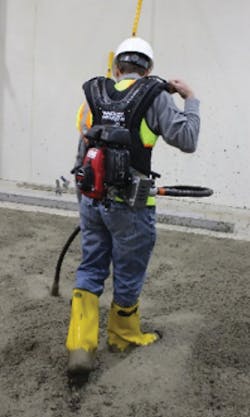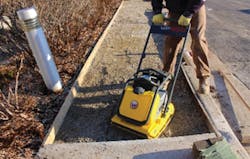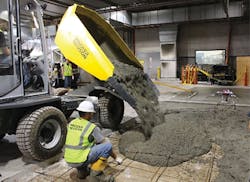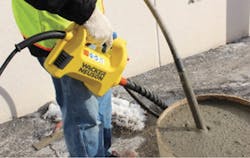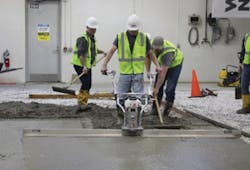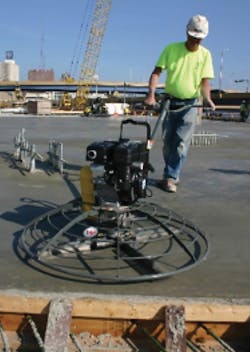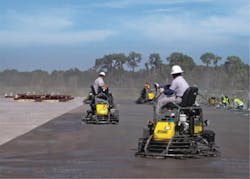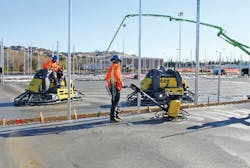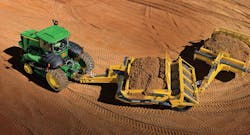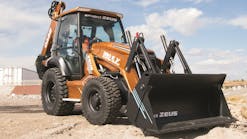When watching a play, movie, or television show, the focus is always on the star performers and actors. What is never seen are the vast numbers of support people serving as stagehands or doing lighting and directing. If they do their job right, nobody should ever know that they even exist. It’s that way with a lot of things in life and in business: a support group is always needed so that those working at the point of application can do their jobs well. Construction is a perfect example of this.
Everyone sees the huge concrete trucks pumping out and pouring the concrete that will form the foundations, floors, and finished structure of the building. But what about the support equipment and personnel who make this operation possible? Once the concrete is poured it has to be worked. This can be done with simple, traditional hand tools (trowels, buckets, wheelbarrows) and personnel protective equipment (PPE—boots, gloves, masks). But heavier, more sophisticated equipment is also necessary, especially for the big jobs. These can include power saws (as well as grove cutters and edgers), screed and floats (often mistaken for each other), water pumps and spraying equipment for water and curing compounds (curing is complete when the concrete reaches its required strength), plate compactors and vibrators, polishers and grinders, skid-steer loaders, and other heavy equipment used in a concrete placement role.
But each concrete job is unique, with different requirements, designs, and placement methods, which raises a few questions. Is there specific support equipment needed for these projects? What support equipment is on the contractor’s “must-have” list? In what order is the support equipment set up and implemented? How does the support equipment play a role in increasing productivity and efficiency?
The Stars of the Show: Concrete Mixing and Placement Equipment
Concrete Plants. A concrete plant is useful to the point of necessity for those really large concrete jobs. Concrete is made by a batch production process. Batch production is defined as “a manufacturing process in which components or goods are produced in groups (batches) and not in a continuous stream.” That is, a concrete plant produces as much concrete as is immediately needed to complete the project. In doing so it increases output, improves consistency, and lowers labor costs.
To make concrete, batch plants combine water with aggregate, sand, cement, and sometimes fly ash. Cement is the binding agent that holds the rest of the concrete mix together. It is a “powdery substance made with calcined lime and clay” and is mixed with water to form mortar or mixed with sand, gravel, and other aggregates, recycled aggregates such as crushed concrete from demolition jobs, and water to make concrete.
Concrete plants are fixed facilities that produce concrete which is then hauled out to the site in concrete trucks. Concrete plants sometimes make their cement or haul in cement from a cement factory. Portland cement production includes the mixing of limestone with clay or shale that has been quarried and put through a crushing process to create a powder. The crushed ingredients are mixed and ground together, then heated in a kiln, followed by the grinding of the resultant clinker into a fine powder. Finally, gypsum powder is added to the mix to create the cement.
Concrete plants take this cement and mix it with the other materials to make a concrete mix. The materials are stockpiled in storage bins until needed and proportioned by weight. Carried by a conveyor belt to a mixer, the dry concrete materials are mixed with water to make flowable wet concrete. Also added are chemical and mineral admixtures that improve concrete performance: accelerating to reduce setting time, air-entraining to increase concrete durability in cold climates, water-reducing to minimize water requirements, damp proofing, etc.
Concrete Pumps. Once the concrete arrives onsite, it has to be placed. Concrete is a flowable material with its viscosity determining the self-leveling and pumping behavior of the concrete mix. To move concrete when wet requires a specialized pump. Since the invention of the twin-cylinder hydraulic concrete pump back in the 1950s, this design has become the worldwide standard. As the pump operates, one piston moves to extract liquid concrete from a storage hopper while the other pushes the concrete into a discharge pipe at the same time. A control valve switches back and forth as the piston moves, first opening one cylinder to the hopper and the other to the discharge pipe, then vice versa. In this way, the cylinders switch back and forth from loading to discharging.
The result is a pumping action with high head and low flow volume. This allows the placement of concrete in the floors of high-rise buildings and hard-to-reach foundation structures, replacing concrete-loaded buckets that were lifted into place by cranes. In addition to improved productivity, pouring concrete straight out of the end of a hose allows for precise placement in a controlled fashion. The constant flow rate increases the volume of concrete that can be placed during a workday, resulting in lower labor costs and quicker placement and shorter setup times.
Concrete pumps come in several configurations. A basic stationary concrete pump extracts concrete from a storage hopper onsite. The use of transport vehicles, booms to control the discharge point, and a local mixer to make the concrete results in a variety of pump types. Given the high heat generated by concrete pumps, stationary pumps can rely on very long discharges hoses which can snake through a job site until it reaches the discharge point. This allows for concrete placement in high-rise buildings and deep tunnels where vehicles cannot go. Concrete vehicles include pumps mounted on truck chassis or mixer trucks that actively mix the concrete while on the way to placement with the pump instead of the traditional gravity flow via a discharge chute.
Portable Concrete Mixers. For smaller batch jobs, portable mixers are the best approach. Mixers are used to make small quantities of concrete at the job site, quantities that do not justify an order of already mixed concrete delivered by truck. They range in size from units small enough to be manually loaded from the back of a pickup truck to large mixers that are hauled to the site while being towed by a truck. Power to run them can be from electrical generators or diesel or gasoline power motors. Mixing takes place in a rotating drum that gets fed the ingredients for concrete until it achieves a uniform consistency and even distribution of the materials.
Concrete Trucks. These trucks are what people generally think of when they consider concrete pouring jobs. Simply put, these are self-mobile cement mixers capable of transporting a large load of concrete to job sites. They consist of a truck cab and chassis, a hydraulic system to provide power to its mixing drum and other power systems, a water storage tank and water feed system for adding water while moving, the mixing drum with interior vanes that keep the concrete mix agitated, a manual operating system that controls the pouring operation, a feed hopper and outlet hopper that discharge the concrete mix, and the discharge chutes that direct the concrete to its application point.
While transporting the cement to the job site, the drum is constantly turning on its drum support rollers to keep the mixture in a liquid state. Typical mixing speed is 6–18 mixing revolutions per minute with an agitating sped of 2–6 rpm. The cement has to be discharged before completion of 1.5 hours of mixing or 300 revolutions. Once it arrives, the concrete truck can be deployed to the current work area, parked over its application point, and allowed to discharge its contents. Trucks can be configured for either front or rear discharge. Those working with a pump deployment system can be located as needed within reach of the hose discharge length.
The Supporting Cast: Auxiliary Equipment
Safety First: Proper Personal Protection Equipment (PPE). PPE is used where existing hazards cannot be controlled by other engineering redesigns, elimination, or substitution of the hazards. Concrete work—though a better-controlled environment than a natural setting with hidden dangers, an urban job site with buried dangers, or excavation work with potentially dangerous soil conditions—can be physically demanding, and it poses potential dangers of its own. All construction work is inherently difficult with most having an innate level of danger that cannot be eliminated by engineering controls or design. PPE is, therefore, the last defense for concrete workers.
PPE is rated for multiple levels of protection from Level D (lowest) through Level A (highest). For most concrete work, Level D is sufficient with hardhat, reflective vest, steel-toed boots, eye protection, work gloves, hearing protection, etc. Eye protection is important since liquid concrete tends to splatter; Portland cement in particular is very caustic and can result in skin or eye burns. Concrete jobs are inherently noisy with concrete pumps, truck engines, vibrators, and compactors all adding to the din. This makes ear protection, or at least the use of earplugs, essential. Dust masks are also important during the mixing of concrete to prevent the inhalation of dust from things like sand, gravel, and cement particles. Rubber gloves are needed to protect hands from the chemical and mineral admixtures present in concrete mix (according to OSHA, skin damage rates are the worst cause of concrete worker injuries and downtime). The gloves should be puncture- and cut-resistant neoprene or rubberized cotton or nylon. Rubber boots and hip waders of similar manufacture are needed for workers standing in wet concrete as it is placed. Grinding, polishing, drilling, or sawing concrete creates a significant amount of dust. Masks are worn to protect workers and prevent inhalation. But a dust collection system actively removes dust from the work area, greatly increasing worker health protection.
Doing It Old-School: Traditional Hand Tools and Manual Power Tools. Not everything is done by machine; a significant part of any concrete job is still done by hand. The most basic tool of all, a flat-edged hand shovel, is needed to precisely place small quantities of concrete where hoses and chutes cannot go. Buckets are still needed for adding water in dry conditions. Moderate amounts of concrete are moved across the job site with wheelbarrows. Rakes are a quick way to get the concrete roughly even and level during the act of pouring. These can be standard garden rakes or more specialized come-along rakes specifically designed for concrete use. Tampers are used to push aggregate below the surface of low slump concrete to ensure a smooth finish. Flat versions rest directly on the concrete surface while roller tampers are used to work the edges of the concrete placement. Trowels remain essential for placing mortar for any kind of masonry work.
And lastly, there is a whole category of handheld power tools (drills, rotary hammers, power saws, edgers, groovers, and cutters). Concrete cutting saws are common on any concrete job site. Groovers (a.k.a. “groove cutters”) are used to create expansion joints in sidewalks, driveways, walkways, and concrete slabs. These tend to be smaller handheld tools used in finished work that is not suitable for larger concrete saws. A rounded finish to the cuts is provided by rounded sides that allow for shaping of the final grooves. An edger is a specialized version of the groover designed to shape the edges of concrete pavement. Concrete saws find their primary use in demolition work, using diamond blades for cutting through concrete and the reinforcing steel underneath. For large steel reinforcement bars, reciprocating saws or chop saws are used to slice through rebar.
When completely poured and set up, concrete slabs and other surfaces often need to be polished to get a proper finish. There is a wide variety of types of sizes of concrete polishers and grinders that can be used to finish the surfaces of everything from a parking garage floor to a kitchen countertop. Large floor models tend to be walk-behind units with other polishers being handheld power tools. Instead of a smooth finish, grinders can be used to create a rough or distressed finish for aesthetic or safety reasons to create a higher friction surface and improve driving safety.
Flatwork and a Smooth Surface: Screeds and Floats. These two tools are often confused. Screeds are used to level freshly poured concrete to the correct grade and level. They are used immediately after the concrete is poured and has not yet set up. They come in custom sizes and are usually a flat blade or stiff tubing that is longer than the width of the pour so that the screed can ride on top of the concrete forms around the edge of the pour. More advanced commercial screeds come with level bubbles or are assisted by a laser to guide the operator and ensure a flat level surface. Though most jobs are screeded manually, motor power roller screeds are used to roll out pervious concrete and ensure proper compaction.
Floating is a different task than leveling. Typically made from magnesium, a float is designed to work the concrete’s final surface and ensure proper embedment of the aggregates and raise liquid cement to the surface and ensure a smooth or glossy finish. Bull floats are employed immediately after the concrete has been screeded. This is done before the bleed water appears on the surface.
Once the final grades are level and smooth, and while the concrete is still wet, the concrete surface receives a coating of curing compound via a spray applicator. This application reduces cracking and helps the concrete cure within the proper time frame. A cover of curing blankets can also be used over the surface to protect against the cold.
Compaction in Place: Plate Compactors and Vibrators. To create a dense and tightly packed foundation for a concrete structure or slab, vibration is needed. Plate compactors apply vibratory loads to layers of sand and gravel placed in the concrete subbase before the concrete pour. The vibratory loads reduce the percentage of the soil that is void space (sand and air as opposed to the soil particles themselves). They also help level the base of the concrete, especially in unstable soils. In addition to plate compactors, vibratory rammers (a.k.a. “jumping jacks”) can be used for small areas or the bottom of trench foundations, while vibratory rollers can be used for larger slabs.
Vibrators work the concrete itself. By applying vibratory loads, they settle and compact the concrete either while it is being poured or while it is setting up. By repeatedly shaking the concrete at high speeds, these vibratory load cycles eliminate air pockets, increasing the strength and density of the concrete. The result is a more durable and long-lasting concrete. At the factory, table vibrators shake concrete that is in a mold so that it can be cured into a solid concrete part or pipe segment during manufacturing. Screeds can be equipped with vibrators so that they vibrate as they level the concrete surface. Form work can also be equipped with vibrators which then allow the forms to shake and densify the concrete within their limits.
Shaking concrete externally with a vibrator attached to the forms is used when steel reinforcement would get in the way of internal vibrations or the concrete structures are too high or made from complicated shapes, making the placement of an internal vibrator more difficult. For larger, deeper concrete structures such as columns, walls, and deep footings, there are internal vibrators—essentially, large vibrating probes that can be immersed into the concrete to allow vibration deep inside the curing concrete.
Laying Pavement. For roadways, parking lots, highways, and large slabs, paving machines are the right choice. They ride over the area of placement, placing concrete to establish grade while creating a final surface. Specialized pavers are used to construct airport runways, bridges, canals. Two methods (fixed forms and slip forms) are used to place concrete. Concrete paving machines use the slip form method where the forms are used to confine the concrete and define its edges being attached to the underside of the machine which travels along the roadway alignment on tractor treads. Concrete is placed in front of the machine as it moves forward and the machine consolidates, levels, and places the concrete.
When higher densities are required, pavement can be placed with power trowels. These are walk-behind machines designed for use on large concrete slabs. With the force of impact generated by these machines, concrete can be placed to a much higher density than hand trowels while greatly reducing labor costs and increasing productivity. General finishing models are the basic versions of this machine with high horsepower models used for heavier densities and variable speeds for different flooring and pavement applications. Ride-on trowels are used for very large slab pours (as much as an acre per day or more) with the operator manually steering and operating the machine.
Concrete placement is a team effort, requiring the coordination of dozens of individual pieces of equipment each with their roles to play and each making the main effort of placing the concrete possible. Newer machines and advanced methods are always being developed. “Concrete construction and its process is certainly not a new practice, but the equipment used to provide solid foundations and flat floors continue to improve the way contractors work. Manufacturers are always looking for ways to improve the process through equipment innovations that will save contractors time and money,” says Luke Sevcik (Wacker Neuson, Corporation Product application/training specialist). “Concrete contractors understand that the quality of their finished product depends on following a defined process. From site prep to final finish, the basic equipment list needed varies only slightly depending on if the job is residential, new construction, specialty concrete, or a larger commercial concrete project.”
Major Suppliers
Caterpillar Inc. If there is a versatile, do-it-all “mule” for concrete construction sites, it would be the skid-steer loader or compact track loader. These are small, nimble machines with lift arms typically equipped with a bucket for excavation. They can also come equipped with backhoes, trenchers, grapple buckets, loader buckets, leveling dozing blades, hoppers, concrete wheel saws, and cement mixers. For high accuracy grading or leveling work, they can be equipped with box blades and paired with laser or GPS grading systems. For concrete work, their primary use is for excavation and leveling the foundations for concrete placement. Caterpillar skid-steer loaders range from the model 226D3 at 67 hp and 5,849 pounds operating weight to the model 272D3 XE, whose CAT C3.8 DIT turbo engine generates 110 hp and weighs in at 9,573 pounds. Rated operating capacities (50% of the tip load) range from 1,530 to 3,560 pounds. These machines find a wide range of uses in addition to concrete work such as agriculture, general construction, load transport, landscaping, and road work. They all come with a high-performance hydraulics system that delivers maximum power to the load lifter, the wheels, and the auxiliary circuit to drive work tool attachments. Attachments are connected through quick connect hydraulic couplings that allow for an easy switch out of attachments.
United Rentals is a nationwide provider of all types of construction equipment, from large excavators to simple hand tools. Its menu of concrete specific tools is equally diverse. These range from concrete mixing buckets and mixers to push buggies, wheelbarrows, concrete drills, saw blades, concrete grinders, saws, electric concrete vibrators, scarifiers, and vibratory screeds. They even supply PPEs like goggles, glasses, and gloves.
Wacker Neuson is a manufacturer of a wide array of concrete construction and finishing tools. These include both internal and external vibrators and backpack-powered vibrators. Gasoline-powered walk-behind trowels are matched with rider trowels having diameters up to 50 inches. Foundation compaction is provided by two- and four-stroke rammers as well as single-direction or reversible vibratory plates. Compaction can be further provided in tight spaces by their trench rollers and single-drum walk behind rollers. Track loaders and skid-steer loaders are available along with an array of attachment tools (buckets, brooms, buckets with teeth, utility forks, grapples, etc.).
